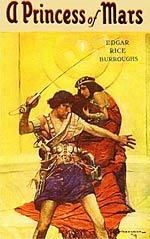
![]() Sable Aradia
Sable Aradia
2/19/2016
![]()
Edgar Rice Burroughs, the writer who gave us Tarzan, published this novel first as a magazine serial and then released it as a completed novel later on. It's always an interesting experience to read classic sci-fi, especially when it's this classic. This pulp legend is loaded with so many tropes it might make the modern reader toss it aside in disgust; except that none of these were tropes when this book was written. And why are they tropes? Because they were amazingly successful and popular, and thousands of writers who succeeded Burroughs tried to imitate what made the John Carter books what they were. These, along with C.S. Lewis' Space Trilogy, were the primordial space operas.
John Carter, ex-civil war soldier and Southern gentleman, is mystically transported to the planet Mars in a fashion that feels more like fantasy than science fiction to the modern reader, except that almost everything that happens after that is sci-fi to the core. John Carter finds that as a denizen of Earth he is considerably stronger and can leap incredible distances compared to the native Martians, who are adapted to Mars' lesser gravity; which, of course, would be exactly what would happen by all laws of physics and biology, if Mars were actually inhabited (though this is also ignored in some places; for instance, Martian riding beasts have no trouble carrying John Carter, although he is certainly more dense, and therefore much heavier, than the people of Mars, which is called "Barsoom" by its inhabitants.)
Carter initially finds himself among the savage green men, who are twelve to sixteen foot tall green, four-armed aliens with great tusks like orcs; where he, through a strange combination of coincidences and misunderstanding of social custom, finds himself both a prisoner and a chieftain; and he teaches the green men about friendship, loyalty and benevolence, which are qualities they have forgotten because limited resources on the dying world of Mars have demanded a more savage way of life of its denizens. Then he ends up meeting the more human-like, more technologically and culturally advanced (but smaller and weaker) red men of Mars, where he meets the princess who motivates him to acts of heroism that read like mythology; which of course also make the John Carter books the primordial planetary romance.
As a modern reader I found that I was impressed by much of the implied technology, which included but was not limited to anti-gravity vehicles, terraforming, and the rudiments of nuclear power and plasma weaponry (described as being powered by radium or something similar.)
Aside from the fact that this standard story formula has become the essence of the default science fiction plotline and setting (clearly guiding, among other things, the standard plots of the original Star Trek series,) I can see so many direct influences in many other ways. The Gor novels are essentially Barsoom updated, kinkified and taken to the extreme; the Dark Sun novels borrow the "savage world of limited resources" setting whole-hock, and I think we even get the fact that Mork hatched from an egg from this novel, since the people of Barsoom are born thus. We even get our scantily-clad heroes and heroines from Burroughs' work; the Martians wear jewelry and combat harness, but not clothing.
There is much to irritate the modern reader if you allow it to. Racism and sexism is rampant, as is the hypocritical logic of Colonialism, and as I've said, it's full of what have become tropes. The writing of the time is prone to contrived plot conveniences and dei ex machinae. There's a lot of telling and not showing, which of course is considered bad writing by modern convention. And yet it's a damn good read that keeps you pressing on to the very last page. It took me only a day to burn through it even though I don't have as much time to read as I would like on working days.
Refreshing, however, to the modern reader, is the fact that despite his Colonialism, John Carter is a man who tries always to do the right thing as he sees it at the time, and in this age of dystopias and anti-heroes, this is like a breath of fresh air. And the style is an easy read that is appropriate for everyone from teens to octogenarians and up.
Everyone who considers themselves a sci-fi or fantasy fan should read this book, whose influence is clearly underrated. Despite, or perhaps especially because of, the tropes.